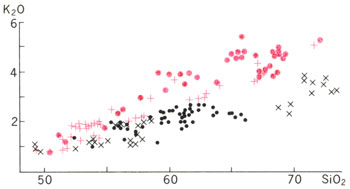Aso Volcano
Introduction / Topography of the caldera / Growth history of Aso volcano
Volcanoes within the caldera and their rocks
Nakadake
Rocks of Aso volcano / Hot springs and groundwater
Eruptive activities
Surveillance and observation of activities
References
![]() PREV
PREV ![]() NEXT
NEXT
Rocks of Aso volcano / Hot springs and groundwater
Rocks of Aso volcano
Rocks of Aso volcano show a wide chemical compositional range from basalt with SiO2 4.9 % to rhyolite 72 %. From pre-caldera rocks such as Aso-1 to Aso-4 to post-caldera rocks, they make a chemically characteristic group. Compared to rocks from contemporaneous volcanoes such as Kuju and Unzen as well as rocks of the earlier ages ( 2,000,000 to 500,000 years before present ) from Aso area, they are rich in alkalis, potassium in particular, and clearly discriminated from others ( ![]() Fig. 4 ). Rocks from later stages of pyroclastic activities of from Aso-1 to Aso-4 are characterized by silicic nature with high SiO2 followed by andesite while rocks from post-caldera stage are rich in basaltic andesite compositions followed by dacite. Chemical compositions of representative rocks are shown in
Fig. 4 ). Rocks from later stages of pyroclastic activities of from Aso-1 to Aso-4 are characterized by silicic nature with high SiO2 followed by andesite while rocks from post-caldera stage are rich in basaltic andesite compositions followed by dacite. Chemical compositions of representative rocks are shown in ![]() Table 2.
Table 2.
Mineralogically, silicic phenocrysts are all plagioclase. Phenocrystic Mg-Fe silicates are mostly clino/ortho pyroxenes±olivine, but the more mafic the rock, the more olivine and less orthopyroxene would appear. Hornblende is restricted in Aso-4 pyroclastic rocks among pre-caldera rocks, and Hontsuka volcano among central volcanoes. Biotite occurs only in Volcanological Laboratory lava flow in contrast to abundant hornblende phenocrysts and common occurrences of biotite phenocrysts in Kuju / Unzen volcanoes.
Hot springs and groundwater
Hot springs are common in the west and north within the caldera. Yunotani, Tarutama, and Jigoku Hot Springs at the western flanks of central volcanoes are simple ( sulfuric ) type accompanied with high temperature steam. Tochinoki Hot Spring at the bottom of Shirakawa Gorge, and Uchinomaki and Akamizu at NE bottom of the caldera belong to sulfate spring type while Teno and Katasumi Hot Springs of NE bottom of the caldera are simple type.
Annual precipitation of this area amounts to 3,400 mm. As upper part of the volcanoes has good water permeability, surface water is very rare and reappears as springs at the bottom of the volcano in abundant good quality water. Among the springs in Aso Valley, an area from Miyachi, Ichinomiya to Yakuinbaru, Aso is rich in artesian wells. Perhaps availability of good water was the reason why Aso shrine area at Miyachi was one of the earliest settled villages in the valley. Many artesian wells are also known in Nango Valley and Shirakawa Spring at Hakusui was designated as one of the hundred good water sources in Japan by Environment Agency in January 1985.

